Snakes are wonderful reptiles that have evolved into fierce predators in the animal kingdom. They have keen senses for hunting prey, multiple options for capturing said prey, and expressive colors and patterns. Snakes are amazing creatures and they have adapted to process food with minimal effort in order to sustain themselves.
This article details how these majestic creatures eat and how often they need to eat to keep their muscular bodies in top form to survive in the wild.
How Often Do Snakes Eat?
Depending on the size and age of the snake, these reptiles have different feeding times.
Some species only eat four times a year, but other more active snakes eat once a week even as adults. The variation is wide and depends greatly on the snake’s overall health, age, species, and size.
Feeding a Pet Snakes

Ball pythons are good pets for first-time reptile owners, as they are easy to handle and need little feeding.
©David Kenny/iStock via Getty Images
Popular pet snakes such as ball pythons should be fed once a week as juveniles, but mature snakes are closer to once a month. Ball pythons are also notorious for going on food strikes, where they do not eat for several months. They can also be a little picky, where some will prefer live mice, they can hunt and constrict while others may enjoy an already dead mouse that has been gently heated up.
Understanding the unique personality of a ball python is a wonderful joy of snake ownership.
What Do Snakes Eat?
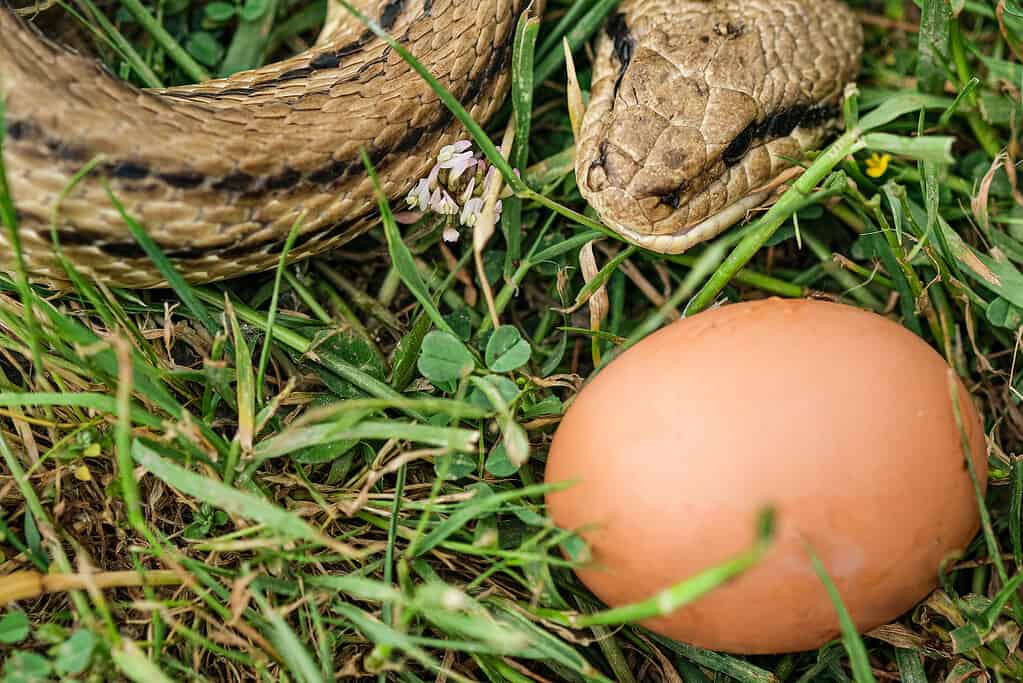
Ground-dwelling snakes will seek out easy sources of food like eggs burning in the dirt or nests.
©Neurone89/iStock via Getty Images
Snakes are exclusive carnivores. They are one of the few species that do not gain any nutritional support from fruits or vegetables. Some snakes have preferences as to what they will eat, but the general idea is that snakes will eat any prey that can swallow whole without risking injury to themselves.
A snake’s diet typically consists of:
- Rodents (mice, rabbits, chipmunks, etc.)
- Birds
- Amphibians
- Fish
- Worms
- Other snakes
- Lizards
- Bats
- Eggs
Large snakes like boa constrictors and anacondas are capable of eating deer, monkeys, capybaras, jaguars, and pets that are left unattended.
How Do Snakes Hunt Prey?
Snakes possess heightened senses to track their prey through several options for all types of situations.
Tracking Prey
All great predators must know how to find and follow their prey through a cavalcade of assorted scents, sounds, and distractions present in nature. Snakes track their prey using their sense of smell and sight.
Sense of Smell
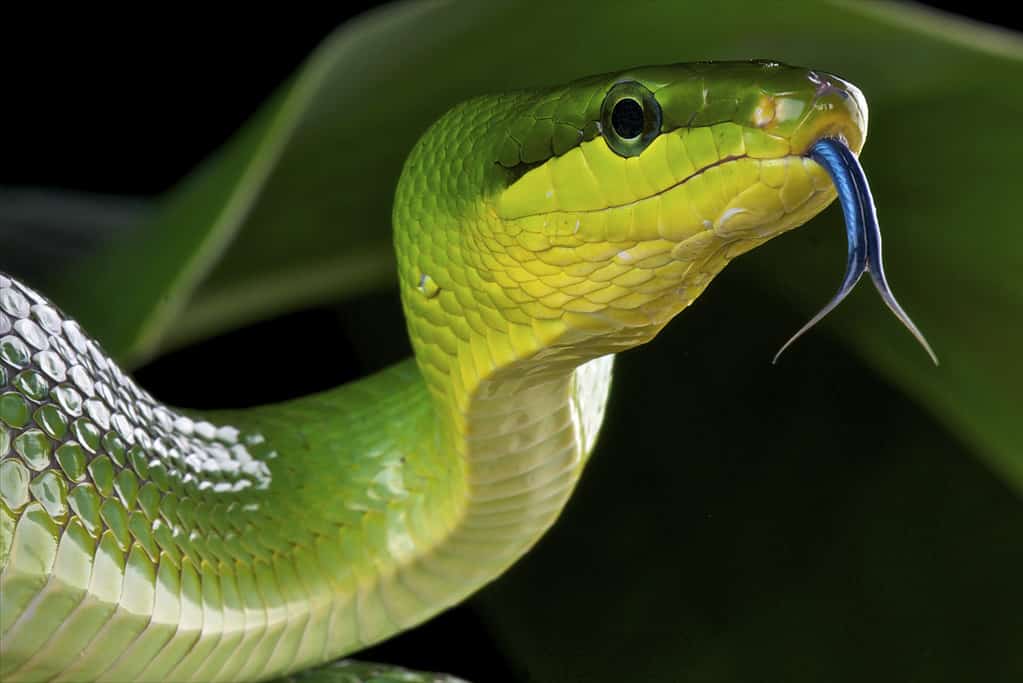
The red-tailed green rat snake is a large nonvenomous snake that uses its tongue to smell.
©reptiles4all/iStock via Getty Images
Snakes have multiple smell receptors on their forked tongue and the roof of their mouth. By flicking their tongue in the air, snakes can detect the scent of prey. Their forked tongue allows them to analyze which direction the prey has moved. The smell travels up the tongue, to the roof of the mouth, to the vomeronasal or Jacobson organ. The Jacobson organ informs snakes what type of prey they are tracking and the direction of movement.
Sense of Sight
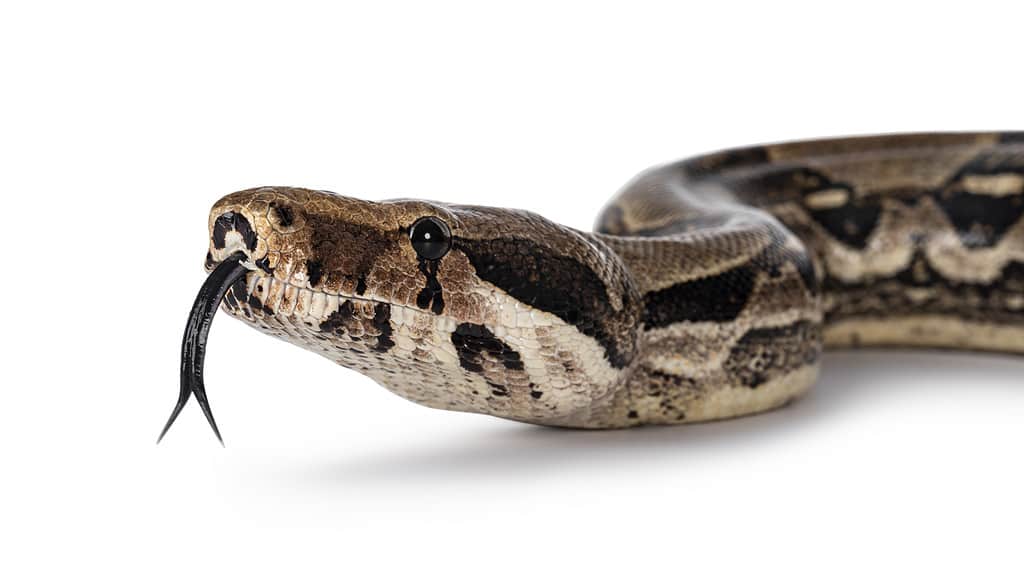
Boa constrictors have heat-sensing pits that help them follow heat signatures left behind by prey.
©iStock.com/Nynke van Holten
Snakes have varying amounts of eyesight, depending on the species. However, most scientists believe they don’t see much in the way of color, making the black and white of night-time more effective.
Heat-Sensing Pits
A few snake families have an additional sense — heat-sensing pits. This unique evolutionary trait makes it possible for them to accurately detect small temperature changes and accurately find their prey, even on the darkest nights.
Most pythons, boas, and all pit vipers have this special ability.
Ambushing Prey
Once the snake picks up their prey’s scent, it will stalk it until the prey comes to a stop to rest or drink water. Snakes camouflage themselves within the surrounding environment to quietly slither closer to their prey until they are in striking distance. When they are close enough to accurately determine the size and distance of their target, they use powerful muscles across their entire body to strike.
Tree-dwelling snakes will traverse the canopy of tall trees, staying out of sight of prey lurking below. Instead of striking from behind or the side, snakes may drop down on their prey and grab them before the animal has a chance to react.
Foraging for Food
Young snakes are less experienced at stalking where they seek out other sources of nutrition. Foods such as eggs, insects, and worms are easy pickings and provide enough energy to sustain them. Eggs are a delicious prize for snakes, as one of these tasty morsels can satisfy their appetite for several days. They also remember to return to the nest if they need more food.
How Do Snakes Catch Prey?
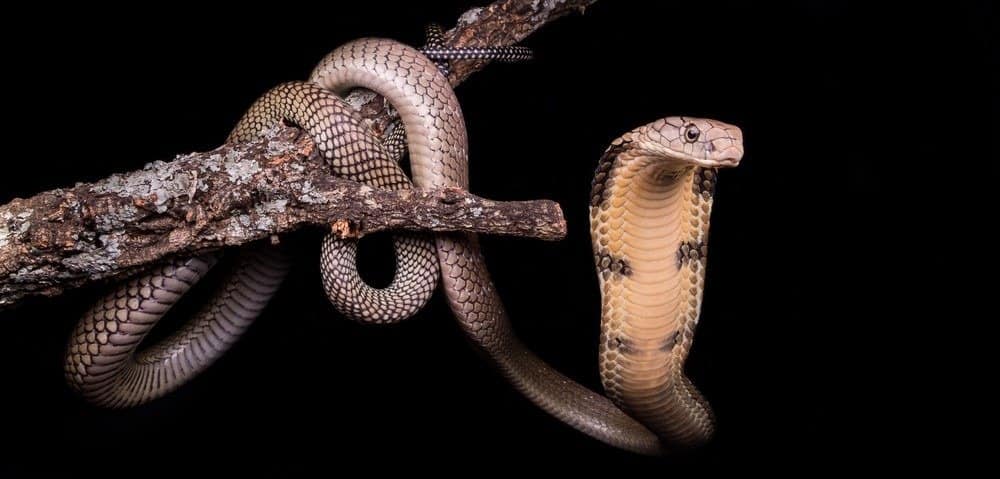
King cobras are highly venomous snakes that can launch their venom like a projective to stun prey.
©Sibons photography/Shutterstock.com
Most snakes are not active hunting predators. They are highly capable trackers, but they will not usually chase their prey. Snakes spend most of their energy regulating their body temperature and digesting food to keep the strong muscles lining their body healthy. Chasing food burns up too much energy, leaving them vulnerable when they become exhausted.
Snakes use two methods for catching prey, venom, and constriction.
Venom
Snake venom is a neurotoxin that is injected directly into the prey’s bloodstream to cause internal bleeding, paralysis, and possibly death, depending on the dosage and lethality of the venom. Not all snakes have venom, and each venom has its range of symptoms and health effects.
When a snake targets its prey, it will use all the muscles in its body to quickly lash out and perform a quick and surgical bite. Within a few seconds, the venom is released into the prey and succumbs to the neurotoxin.
When the prey stops moving or is deceased, the snake will eat the prey without worrying about being injured by it.
Several snakes like vipers, cobras, and sea serpents have venom so strong that they can kill a human within hours if an anti-venom is not administered.
Constriction
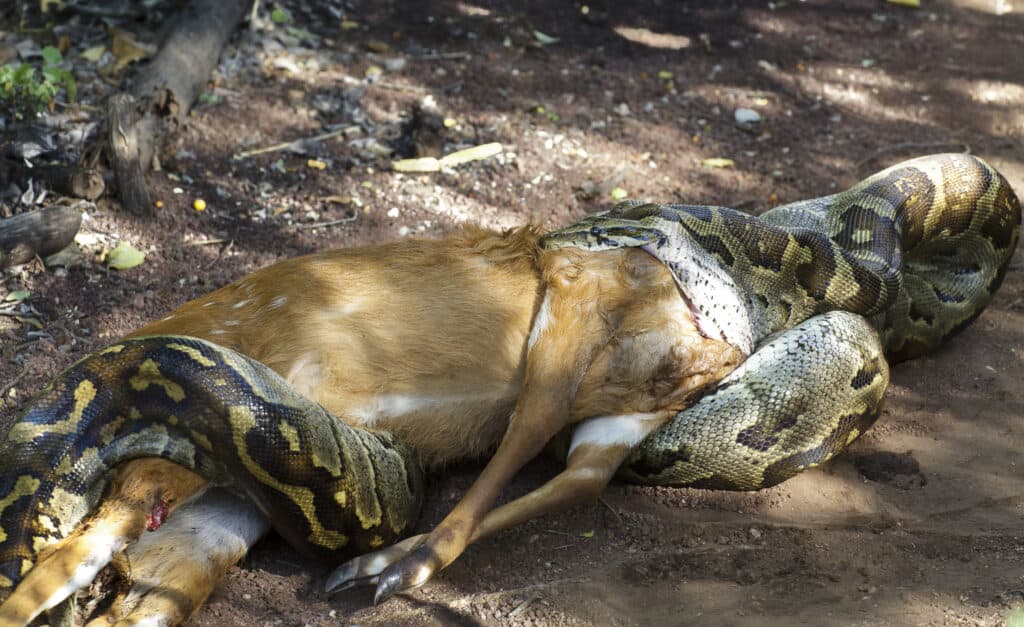
Large snakes like the
Burmese python
are so big, they can constrict and eat whole deer.
©iStock.com/JedsPics_com
Snakes like boa constrictors, ball pythons, and anacondas do not use venom. Instead, they use their powerful muscles to coil around their prey, squeezing the life out of them before feasting.
Once prey has been captured and wrapped within the many coils of the snake, there is truly little the prey can do to escape. Snakes will grip tighter when they feel their prey trying to breathe in for more oxygen.
Emerald tree boas wrap themselves around their prey and carry their meals to a safe location or a knot hole in a tree so they may digest in peace. Larger snakes like Burmese pythons and anacondas are so big, they will digest their food the moment the prey is dead since other predators will avoid them.
How Do Snakes Digest?
Snakes spend the majority of their day digesting their food and sunbathing to regulate their body temperature.
Breathing While Eating
First, the snake ensures their prey is incapacitated. Once the prey is confirmed defeated or killed, they expand their jaws wide enough to swallow the prey whole. Snakes do not chew their food.
Their windpipe is located along the bottom jaw. The windpipe sticks out underneath the food, allowing the snake to comfortably breathe while it eats.
Next, the jaws hook onto the prey and widen to wrap around the carcass’s body. Snakes have small, backward-facing teeth to dig and hook into the flesh, making it easier to grab hold of the prey and pull it inward.
Snake Digestion Process
The prey is pulled into the esophagus, which can stretch to accommodate the size of larger animals. The esophagus muscles constrict the prey, sliding it down into the stomach for digestion.
A snake’s stomach is shaped like a large J. The stomach secretes powerful digestive enzymes which break down the flesh, muscle, organs, and bones.
The food is broken down into essential nutrients and proteins which fuel the whole body.
All in all, snakes are magnificent creatures that have evolved to hunt, track, capture, and digest prey to fuel their impressively muscular bodies. They need to eat once or twice a week, then spend the rest of their day lounging in the sun to digest and keep warm.
The photo featured at the top of this post is © tikephoto/iStock via Getty Images
Discover the "Monster" Snake 5X Bigger than an Anaconda
Every day A-Z Animals sends out some of the most incredible facts in the world from our free newsletter. Want to discover the 10 most beautiful snakes in the world, a "snake island" where you're never more than 3 feet from danger, or a "monster" snake 5X larger than an anaconda? Then sign up right now and you'll start receiving our daily newsletter absolutely free.
Thank you for reading! Have some feedback for us? Contact the AZ Animals editorial team.







